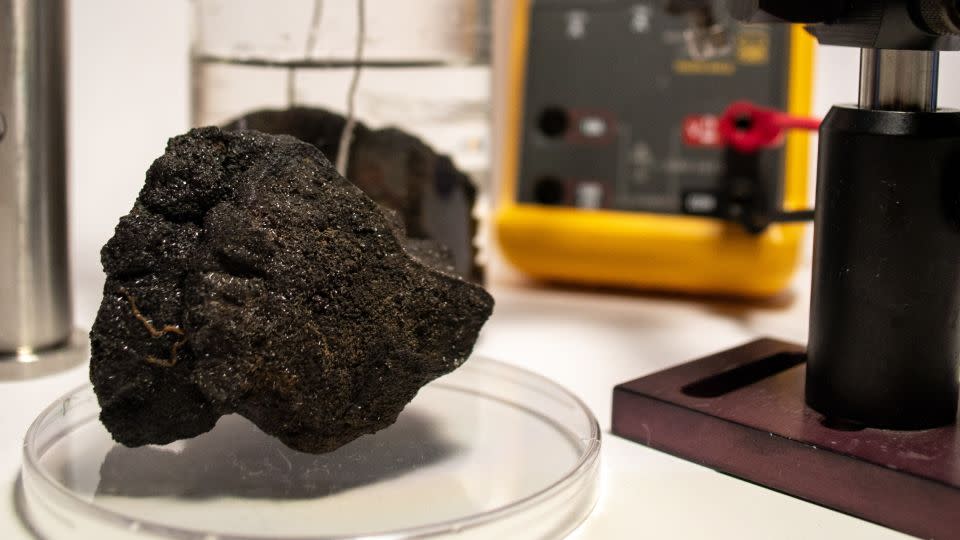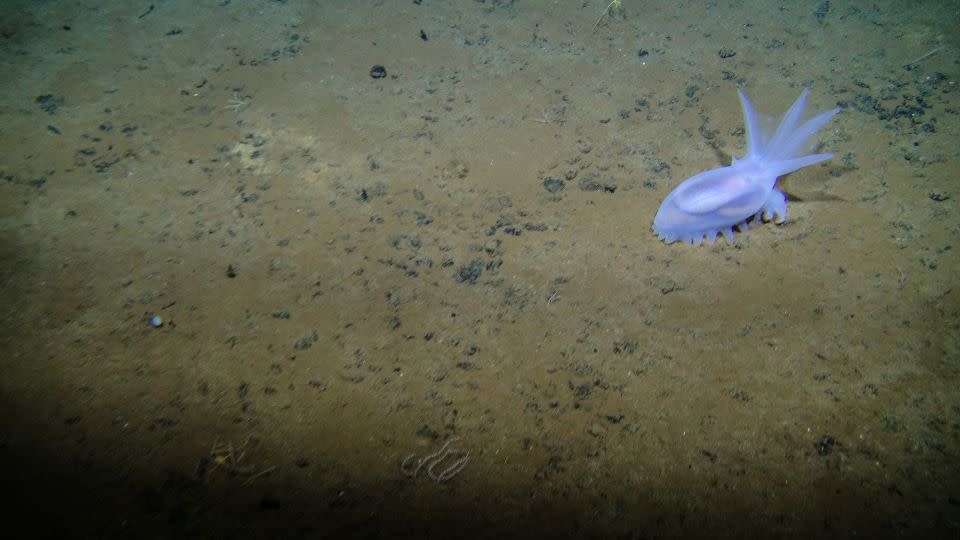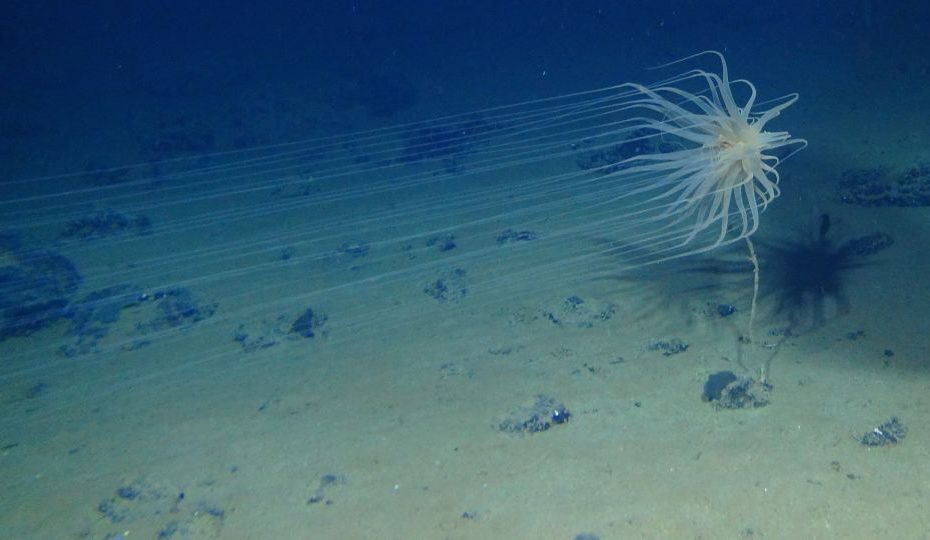Sign up for CNN's Wonder Theory science newsletter. Explore the universe with news about fascinating discoveries, scientific developments and more.
A mysterious phenomenon first observed in 2013 aboard a ship in a remote part of the Pacific Ocean seemed so absurd that ocean scientist Andrew Sweetman was convinced his measuring equipment was faulty.
Sensor readings seemed to indicate that oxygen was being made on the seafloor, 4,000 meters (about 13,100 feet) below the surface, where no light can penetrate. The same thing happened during three subsequent trips to an area known as the Clarion-Clipperton Zone.
“I basically told my students to just put the sensors back in the box. We’ll send them back to the manufacturer and get them tested, because they’re just giving us crap,” said Sweetman, a professor at the Scottish Association for Marine Science and head of the institution’s seabed ecology and biogeochemistry group. “And every time the manufacturer would come back and say, ‘They work. They’re calibrated.’”
Photosynthetic organisms such as plants, plankton and algae use sunlight to produce oxygen that travels to the depths of the ocean. However, previous studies in the deep sea have shown that oxygen is only consumed, not produced, by the organisms living there, Sweetman said.
His team's research challenges this long-held assumption and discovers that oxygen is produced without photosynthesis.
“You're cautious when you see something that goes against what should be happening,” he said.
The study, published Monday in the journal Nature Geoscience, shows how much remains unknown about the ocean’s depths and underscores the stakes in the effort to exploit the ocean floor for rare metals and minerals. The discovery that there is a source of oxygen on the planet other than photosynthesis also has far-reaching implications that could help unravel the origins of life.
Seabed sampling
Sweetman first made the unexpected observation that “dark” oxygen was being produced on the seafloor while assessing marine biodiversity in an area designated for mining potato-sized polymetallic nodules. The nodules form over millions of years through chemical processes that cause metals to precipitate out of the water around shell fragments, squid beaks and shark teeth, covering a surprisingly large area of the seafloor.
Metals such as cobalt, nickel, copper, lithium and manganese found in the nodules are highly sought after for use in solar panels, electric car batteries and other green technology. But critics say deep-sea mining could irreparably damage the pristine underwater environment, with noise and sediment plumes created by mining equipment harming midwater ecosystems and seafloor organisms that often live on the nodules.
It's also possible, these scientists warn, that deep-sea mining could disrupt the way carbon is stored in the ocean, contributing to the climate crisis.
For that 2013 experiment, Sweetman and his colleagues used a deep-sea lander that sinks to the seafloor and inserts a chamber smaller than a shoebox into the sediment to enclose a small area of the seafloor and the volume of water above it.
What he expected the sensor to detect was a slow decline in oxygen levels as microscopic animals breathed it in. From that data, he wanted to calculate something called “sediment community oxygen consumption,” which provides important information about the activity of the fauna and microorganisms on the seafloor.
It wasn't until 2021, when Sweetman used a different, alternative method to detect oxygen and got the same result, that he realized oxygen was being produced on the seafloor and that he needed to understand what was going on.
“I thought, ‘My God, for the last eight or nine years I've been ignoring something huge and profound,'” he said.
Sweetman has observed the phenomenon repeatedly for nearly a decade at various locations in the Clarion-Clipperton Zone, a vast area stretching more than 4,000 miles (6,400 kilometers) beyond the jurisdiction of any one country.
The team took a number of samples of sediment, seawater and polymetallic nodules back to the lab to investigate exactly how oxygen was produced.
unknown content item
–
Understanding Dark Oxygen
Through a series of experiments, the researchers ruled out biological processes such as microbes and focused on the nodules themselves as the origin of the phenomenon. Perhaps, they reasoned, it was oxygen released from manganese oxide in the nodule. But such a release was not the cause, Sweetman said.
A documentary about deep-sea mining that Sweetman saw in a hotel bar in São Paulo, Brazil, provided a breakthrough. “Someone said, 'That's a battery in a rock,'” he recalls. “When I saw this, I suddenly thought, Could it be electrochemical? Could these things they want to mine to make batteries be batteries themselves?”
Electric current, even from a AA battery, when placed in salt water can split the water into oxygen and hydrogen — a process known as seawater electrolysis, Sweetman said. Perhaps the lump was doing something similar, he reasoned.
Sweetman approached Franz Geiger, an electrochemist at Northwestern University in Evanston, Illinois, and together they investigated further. Using a device called a multimeter to measure small voltages and variations in voltage, they recorded readings of 0.95 volts from the surface of the nodules.
These values were below the 1.5 voltage required for seawater electrolysis, but indicated that significant voltages could develop when the nodules were close together.
“It appears that we have discovered a natural ‘geobatterie,’” Geiger, the Charles E. and Emma H. Morrison Professor of Chemistry in Northwestern’s Weinberg College of Arts and Sciences, said in a press release. “These geobatteries provide the basis for a possible explanation of the production of dark oxygen in the ocean.”
Challenging the paradigm
The discovery that abyssal, or deep-sea, nodules produce oxygen is “an astonishing and unexpected finding,” said Daniel Jones, a professor and head of ocean biogeosciences at the National Oceanography Centre in Southampton, England, who collaborated with Sweetman but was not directly involved in the research. “Findings like this demonstrate the value of ocean-going expeditions to these remote but important areas of the world's oceans,” he said by email.
The study certainly challenges “the traditional paradigm of oxygen cycling in the deep sea,” said Beth Orcutt, a senior research scientist at the Bigelow Laboratory for Ocean Sciences in Maine. But the team provided “enough supporting data to justify the observation as a true signal,” said Orcutt, who was not involved in the research.
Craig Smith, professor emeritus of oceanography at the University of Hawaii at Manoa, called the geobattery hypothesis a reasonable explanation for the production of dark oxygen.
“However, (as with any new discovery) there may be alternative explanations,” he said via email.
“The regional significance of such (dark oxygen production) cannot really be assessed with the limited nature of this study, but it does suggest a possible unrecognized ecosystem function of manganese nodules on the deep seafloor,” said Smith, who was also not involved in the study.


Unraveling the origins of life
The U.S. Geological Survey estimates that the Clarion-Clipperton Zone contains 21.1 billion dry tons of polymetallic nodules. These nodules contain more critical metals than all the world's land reserves combined.
The International Seabed Authority, under the UN Convention on the Law of the Sea, regulates mining in the region and has issued exploration contracts. The group is meeting in Jamaica this month to consider new rules to allow companies to extract metals from the ocean floor.
However, several countries, including the United Kingdom and France, have exercised caution and supported a moratorium or ban on deep sea mining to protect marine ecosystems and preserve biodiversity. Earlier this month, Hawaii banned deep sea mining in its state waters.
Sweetman and Geiger said the mining industry must consider the implications of this new discovery before potentially exploiting the deep-sea nodules.
Smith of the University of Hawaii said he supported a pause in mining the nodules given the impact it would have on a fragile, biodiverse and pristine environment.
The first attempts at mining in the area in the 1980s were a warning, Geiger said.
“In 2016 and 2017, marine biologists visited sites where mining had taken place in the 1980s and found that not even bacteria had recovered from the mining areas,” Geiger said.


“However, in unexplored areas, marine life flourished. Why such ‘dead zones’ persist for decades remains unknown,” he added. “However, this puts a big asterisk on seafloor mining strategies, as the diversity of fauna on the ocean floor in areas with many nodules is higher than in the most diverse tropical rainforests.”
Sweetman, whose scientific research has been funded and supported by two companies interested in mining the Clarion-Clipperton Zone, said it is critical that there is scientific oversight of deep-sea mining.
There are still many unanswered questions about how dark oxygen is produced and what role it plays in the deep sea ecosystem.
Understanding how the ocean floor produces oxygen could also shed light on the origins of life, Sweetman added. A long-held theory is that life evolved at hydrothermal vents in the deep sea, and the discovery that electrolysis of seawater can create oxygen in the deep could inspire new ways of thinking about how life on Earth arose.
“I think there needs to be more science done, especially around this process and the importance of it,” Sweetman said. “I hope it's the start of something great.”
For more CNN news and newsletters, create an account at CNN.com

